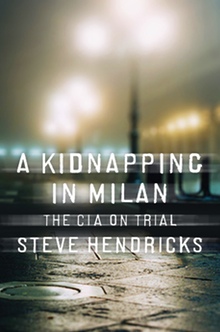Steve Hendricks, an investigative journalist who lives in Knoxville, Tennessee and Helena, Montana, has just published A Kidnapping in Milan, his in-depth study of the botched CIA renditions operation in Italy that led to the conviction of 23 U.S. government operatives for kidnapping and other crimes. I put six questions to Hendricks about his new book.
1. You trace the evolution of the notions of rendition and extraordinary rendition, initially as a tool of American law enforcement, and then as a political tool of the American executive dealing with adversaries abroad—especially drug dealers and terrorists. How does the program developed by the second Bush Administration differ from its predecessors?

Before September 11, 2001, the CIA carried out at least seventy extraordinary renditions—the vast majority, it seems, under Clinton. We know very little about most of these renditions, but the fact of our knowing little suggests they were carried out with a degree of discretion and competence. Under George W. Bush, the quantity of renditions went up and the discretion and competence went down. At the very least Bush rendered several score victims, and more probably a couple hundred. His demands for renditions were so great that, for example, the CIA’s in-house air fleet didn’t have enough planes, so the agency had to lease torture taxis from outside the agency. The CIA also rented many of the renderers—the on-the-ground planners, the heavies who actually grabbed the victims, the in-flight medics, you name it. A lot of them were poorly trained. Then there was Bush’s brazen approach to covert action, which filtered down to the lowest level of the CIA. Even in the best of times, the CIA thinks it can get away with murder (sometimes literally), but under Bush the hubris reached heights not seen since the anything-goes Cold War days. A lot people involved in renditions believed they would never be punished, even when breaking the laws of other countries. For all these reasons, the CIA’s renderers left a lot of prints in a lot of places, Milan being the foremost example.
Bush’s other big innovation in renditions was his infamous black sites. Clinton had always been happy to pass the undesirables he captured to our Third World clients like Egypt and Syria. He preferred to wash his hands of whatever savagery was visited upon them. Bush fils, however, hung onto a lot of these guys, mostly to try to beat some intelligence out of them, an endeavor that enjoyed very little success.
2. The focus of your book is one extraordinary rendition operation: the CIA’s February 17, 2003 seizure of a Muslim cleric, Hassan Mustafa Osama Nasr, usually referred to as Abu Omar, off the streets of Milan, and his transportation to Egypt, where he was tortured and abused over a period of a couple of years. What led you to the case of Abu Omar, and what does it tell you about the renditions program?
The case was compelling for many reasons, not least of which was that Abu Omar’s kidnappers were exposed in spectacular fashion. They left a trail of cell-phone traces, hotel receipts, tollway farecards, credit card numbers, computer files, even a couple of witnesses, all of which enabled Italian investigators to document their crime in stupefying detail. I was also fascinated by the chief investigator, Armando Spataro, a charismatic man who held holy the rule of law no matter how powerful the lawbreaker. Another thing that greatly interested me was that, at the time the CIA kidnapped Abu Omar, the Italian counterterror police had him under thorough and fruitful surveillance. They knew where he was going, what he was planning, to whom he was talking, and they were learning a lot about how the terrorists in his cell were working. When the CIA swooped in and took him, they badly damaged Italy’s work against terrorists. The case, in other words, looked like a good example of how the “war on terror” made the West less safe from terrorists.
A lesser but important finding is that we’re not sending Jason Bournes and James Bonds to do our covert operations. A lot of our black-ops types may know what they’re doing, but we also have a lot who don’t, both in the field and at headquarters in Langley. This doesn’t help our struggle against the bad guys or our standing in the world. When the CIA was founded in 1947, there was a great debate about whether it should be only in the intelligence-gathering business or in the covert-action business as well. The fiasco in Milan is just the latest in a long chain of botched subversions that suggest the CIA isn’t competent to do covert operations.
3. The Abu Omar case led to the indictment and trial of 26 American officials involved in the rendition and the conviction of 23 of them, as three got off on a technical defense of diplomatic immunity. The Wall Street Journal called the chief prosecutor, Armando Spataro, a “rogue” and intimated that he was motivated by anti-American prejudices. You studied his handling of the case in intimate detail. Are the Journal’s characterizations accurate?
The Journal’s editorial writers have long been way out in the right field, and every now and then they race through the warning track and crack their heads against the wall. (Would that it would knock some sense into them.) Armando Spataro spent the 1970s and 1980s prosecuting leftist terrorists, the 1990s prosecuting the Mafia, and the 2000s prosecuting Islamic terrorists. Like several other Italian magistrates, he has a great record of tracking, trying, and imprisoning terrorists, which is more than you can say for the rogues in the Bush administration. Evidently the Journal favors law and order when it comes to welfare cheats and dope pushers but not when a law-and-order man like Spataro goes after the Journal’s fellow travelers on the right.
Spataro’s supposed anti-Americanism might surprise the FBI and DEA, which have commended him for his successful collaborations with the United States on Mafia and drug cases, and the State Department, which hosted him for a comparative study of the American and Italian justice systems. For decades Spataro has traveled extensively throughout America, and the walls of his office are decorated with all manner of American art. He has long believed that the U.S. Constitution is one of the most beautiful pieces of literature in the world. He merely wants America, as so many Americans do, to live up to it.
4. One question that hung over the entire operation was whether it had been coordinated with and approved by the government of then-Prime Minister Silvio Berlusconi. Certainly there was solid evidence that senior figures in Italian intelligence knew about the operation in advance and approved of it. What conclusions did you draw about this, and if it was approved by the prime minister, why did prosecutors proceed with the case?
We still don’t know, and perhaps never will, precisely what Berlusconi knew when. But former high-ranking intelligence officials in both Italy and the United States have said it is unthinkable that the CIA would have carried out an operation like this without first getting Berlusconi’s approval. Certainly Berlusconi was an exceedingly eager abettor of the Bush “war on terror,” and if the Bush administration had asked for his approval, it’s a good bet he would have said yes.
Spataro could nonetheless proceed with his prosecution because in Italy magistrates are almost entirely independent of the prime minister and parliament, as federal judges in the United States are independent of the president and Congress. Far from being a disincentive, once Spataro discovered that the rot went to the top—that Italy’s seniormost intelligence officials had illegally helped the CIA with the kidnapping (and duped other Italian counterterrorists into believing they hadn’t)—he thought it was imperative to follow the criminal trail as far as it led and prosecute the powerful as vigorously as the foot soldiers. The kidnapping had Watergate-level implications for Italy; it was a crime not just against Abu Omar but against the nation. Spataro believed, correctly, that for the benefit of the nation, the wrongdoers needed to be thoroughly “outed” and just as thoroughly prosecuted.
5. No evidence ever emerged to suggest that Abu Omar was actually involved in any pending plot to attack Americans or American interests at the time he was snatched. Nor did he prove to be the significant leader of any military group. At most he appears to have been a recruiter with rabidly anti-American views. So why was Abu Omar targeted and seized?

Abu Omar was almost certainly a terrorist but, as you say, of middling or even lowish rank and without imminent plans to attack. Because the Italians had him under thorough surveillance, they almost certainly would have been able to arrest him if his plans changed, and in any case they were going to arrest him in a month or two when they had gotten all the intelligence they could from his cell. In other words, there was no reason at all to render him, even by the CIA’s own criteria, which amounted to getting the “worst of the worst” off the streets before they could do serious harm.
The most convincing theory to explain why the CIA snatched Abu Omar is that the agency’s chief of station in Italy, Jeff Castelli, wanted a promotion. After September 11, renditions were all the rage in the CIA. Station chiefs around the world were collecting scalps. Several Italians and Americans who worked with Castelli believe he convinced Langley to approve the rendition by exaggerating the threat Abu Omar posed and denigrating the Italians’ monitoring of him. Castelli had boosters at Langley who were grooming him for a higher post, and at least one or two of them were among those who weigh the merits of proposed renditions and approved or denied them. Probably Castelli’s boosters were overly eager to help their man get his scalp.
A lesson here is that although we think of the CIA as a spy agency, it is also—I might even argue it is foremost—a bureaucracy, and its bureaucrats have most of the motivations of bureaucrats elsewhere. Sure, they work for the good of their country as they perceive it, but they’re also looking out for themselves, and career often trumps country. The opportunity for mischief is all the greater because the CIA has very successfully fought off outside oversight and hidden its sins under the opaque cloak of national security.
6. Did Barack Obama end the extraordinary renditions program? If not, what changes did he introduce to it?
A lot of Americans think Obama ended it, but the program is alive and well. Obama did ban U.S. personnel from torturing captives, but, after some initial obfuscation, he said through subordinates that he intended to continue extraordinary renditions, which is to say to continue torture-by-proxy, which is to say to violate, as Bush did, the UN Convention Against Torture, to which the United States is a signatory. In court Obama has argued, again just as Bush did, that lawsuits against the United States by victims of renditions must be dismissed because they jeopardize national security.
Where Obama differs from Bush is that his renditions seem to be fewer and quieter. At least, we can infer they’re fewer because we aren’t hearing about them. It’s possible that he has rendered only a very small handful of people. On the other hand, Clinton rendered dozens of people so quietly that we heard almost nothing of them at the time, and we still know little about most of them. Another difference is that Obama shut down Bush’s black sites, so America has probably returned to the Clintonian practice of handing our captives to our Third World confederates more or less immediately. But it falls to future reporters and historians to discover whether Obama’s crimes against humanity are few or many, even if they don’t live up the impressive mark of his predecessor.



